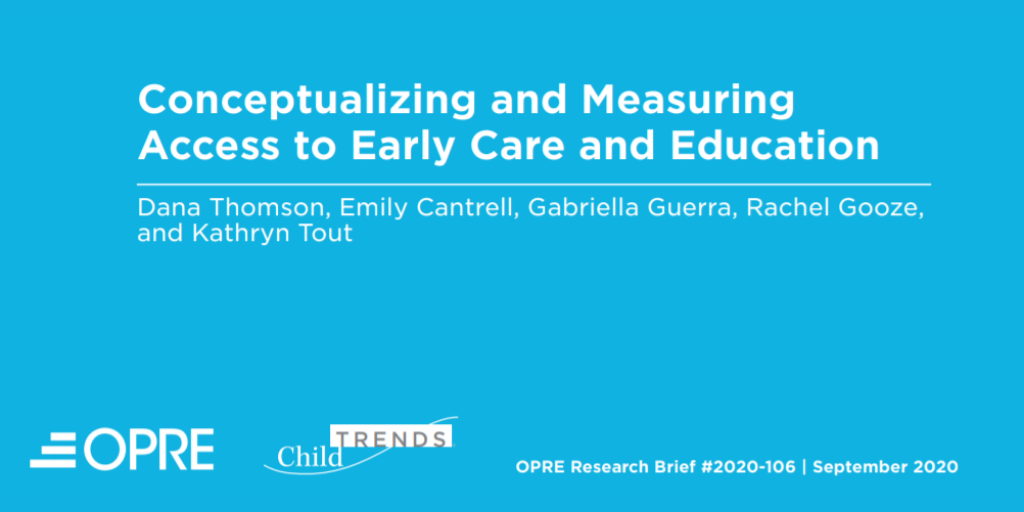OPRE Report Looks at How to Conceptualize and Measure Access to Care

In a new report, the Office of Research, Planning, and Evaluation (OPRE), in collaboration with Child Trends, examines how the early learning field has attempted to measure access to child care as part of the ongoing effort to ensure these vital services are available to all children and families who need them. The report builds on an earlier project, Defining and Measuring Access to High-Quality Early Care and Education (ECE): A Guidebook for Policymakers and Researchers (Access Guidebook), which developed a four-part Access Framework. Specifically, this new report provides findings from a literature review of recent efforts to define and operationalize access with the goals of (1) determining the extent to which the ECE field has developed common language and metrics for discussing, documenting, and ultimately improving ECE access; and (2) sharing the specific indicators researchers have used to measure the Access Framework dimensions.
Establishing a common understanding of ECE access and a set of measurable indicators is essential for identifying and tracking the results of initiatives, making comparisons within or across different settings or geography, and informing policymakers’ decisions about how to strategically invest public funding to promote equitable access.
Summary of the Access Framework
The Access Guidebook emphasizes the importance of considering multiple dimensions of access. Broadly speaking, this means combining metrics based on a systems perspective (e.g., the number of slots available and cost of care) with factors that incorporate family perspective. The more family-centered approach proposed in the Access Framework also looks at the process by which services are sought out and used, in addition to supply and demand. Thus, the framework’s dimensions are oriented around whether the care available (1) requires no more than reasonable effort, (2) is affordable, (3) supports the child’s development, and (4) meets the parents’ needs. These dimensions can be further defined as follows:
- Reasonable effort, including the availability of age-appropriate ECE slots near parents’ homes or workplaces, as well as information about those options.
- Affordable, for both parents and providers, acknowledging parents may have access to financial supports and no-cost options (including Head Start and some care provided by family and friends).
- Supports child development with high-quality, coordinated, stable care that meets children’s unique needs, including supports for children with developmental or physical disabilities, children who are homeless, and children who speak a language other than English.
- Meets parents’ needs, including parental preferences for specific program types or features or the need for extended care, care during nontraditional hours, or care for multiple children.
Summary of the Literature Review
To summarize findings, the report begins by discussing the numerous variables encountered in the review, breaking the four dimensions into additional subdimensions. Based on the literature review, the report also added a fifth dimension, equity, which considers disparities in availability, affordability, quality, and other ECE characteristics. With that background, the report describes the extent to which reports combined multiple dimensions of access and the ongoing challenges to conceptualizing and operationalizing access. These challenges include availability of data across all dimensions, especially as it relates to family-level factors that influence access; the field’s inconsistent use of metrics; and a lack of clarity about how to combine dimensions and data sources to paint a more complete picture of access.
The report concludes with key findings and recommendations for future research. Key findings include:
- Availability, affordability, and use of ECE services continue to be the foundation for most conceptualizations of access. More recent efforts to define access span multiple dimensions, however, including access to services that support the child’s development and the parents’ needs and the removal of structural barriers to ECE for socially or economically disadvantaged or at-risk populations.
- This change in how the field conceptualizes access has also impacted efforts to measure it.
- Challenges remain in operationalizing ECE access from a multidimensional perspective.
To read the complete findings and recommendations, visit the OPRE website.
Subscribe to FFYF First Look
Every morning, FFYF reports on the latest child care & early learning news from across the country. Subscribe and take 5 minutes to know what's happening in early childhood education.



